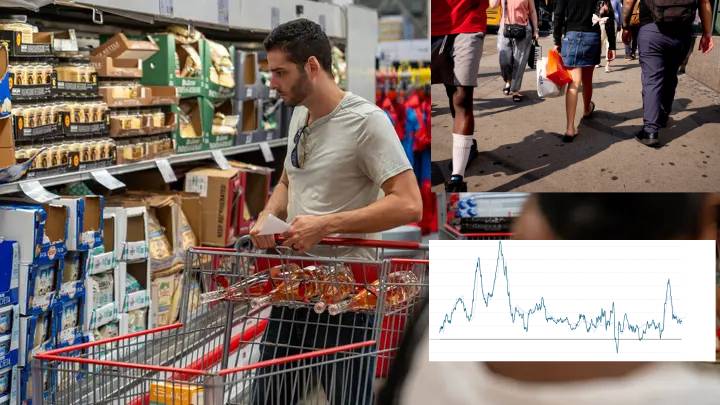
The much-anticipated July 2025 CPI inflation report is out, and it shows that prices are still climbing, though not as fast as some feared. This CPI inflation report from the Bureau of Labor Statistics gives a clear picture of how everyday costs like food, gas, and housing are changing. With inflation holding steady overall but picking up in key areas, many are watching what this means for the economy and the Federal Reserve’s next moves.
Key Highlights from the CPI Inflation Report
In the July 2025 CPI inflation report, overall consumer prices rose by 0.2% from June to July. Compared to a year ago, the inflation rate stayed at 2.7%, which was a bit lower than the 2.8% that experts had predicted. This marks no big change from June, thanks in part to drops in energy and steady food prices.
But when you look at core inflation—which leaves out the ups and downs of food and energy—the story gets a little hotter. Core prices jumped 0.3% month-over-month and hit 3.1% year-over-year, the fastest pace in five months. That’s up from 2.9% in June, showing that underlying price pressures aren’t cooling off as quickly as hoped.
Breakdown of Price Changes in the CPI Inflation Report
The CPI inflation report breaks down where prices are moving the most. Here’s a simple look at the main categories:
- Food Prices: Things stayed pretty flat overall. Grocery prices dipped by 0.1% from June, with eggs falling 3.9% after a big drop last month. But over the year, food is up 2.9%, and eating out costs more with a 3.9% rise.
- Energy Prices: This was a bright spot. Energy costs fell 1.1% in July, led by a 2.2% drop in gasoline. Year-over-year, gas is down 9.5%, helping keep the overall inflation number in check.
- Housing and Shelter: Housing remains a big driver of inflation. Costs rose 0.2% month-over-month and are up 3.7% from last year. This includes rent and homeownership expenses, which keep pushing prices higher.
- Other Areas: Airfares shot up 4% in July after months of declines, and car insurance also added to the pressure. Apparel and household items saw mixed changes, with some increases tied to recent tariffs.
These details in the CPI inflation report highlight how energy and food are offsetting hikes elsewhere, but core items like services and housing are sticking around.
What the CPI Inflation Report Means for the Fed and Interest Rates
The July 2025 CPI inflation report comes at a tricky time for the Federal Reserve. Inflation is above the Fed’s 2% target, but the job market is weakening—with only 73,000 jobs added last month and big downward revisions to earlier numbers. This has boosted the odds of a rate cut in September to over 94%, up from about 86% before the report.
Fed Chair Jerome Powell has said the central bank might “look through” short-term bumps like tariffs if they’re one-off events. But with core inflation ticking up, some worry it could make rate cuts harder. As one expert put it, “Inflation is on the rise, but it didn’t increase as much as some people feared. Longer term, we likely haven’t seen the end of rising prices.”
The Growing Impact of Tariffs on the CPI Inflation Report
Tariffs are starting to show up in the CPI inflation report, though not in a huge way yet. New levies on imports, including a 10% universal tariff since April and higher ones on goods from China and others, are pushing up prices for things like furniture, apparel, and appliances. Businesses stockpiled before the tariffs hit, but now costs are being passed to consumers.
Experts say the full effects are still coming. One economist noted, “The tariff-induced boost to inflation is likely to grow over the coming months.” This could lead to higher inflation by year’s end, maybe pushing it to 3.2%, and raising fears of “stagflation”—slow growth with rising prices.
Expert Takes on the CPI Inflation Report
Reactions to the CPI inflation report are mixed. Some see it as good news for rate cuts, while others warn of tougher times ahead. A chief economist said, “Investors must come to grips with inflation above the Fed’s target amid a backdrop of slower growth, setting things up for stagflation-lite.” Another pointed out, “There is some sign of tariff pass through to consumer prices but, at this stage, it is not significant enough to ring alarm bells.”
Even President Trump weighed in, criticizing Fed Chair Powell and calling for lower rates now.
Wrapping Up the July 2025 CPI Inflation Report
Overall, the July 2025 CPI inflation report paints a picture of stubborn inflation that’s not spiking but not vanishing either. With tariffs looming larger and the job market softening, the economy could face more challenges. Keep an eye on future reports—they’ll be key to understanding if prices cool down or heat up further. For everyday folks, this means watching budgets closely as costs in housing and travel keep rising.
